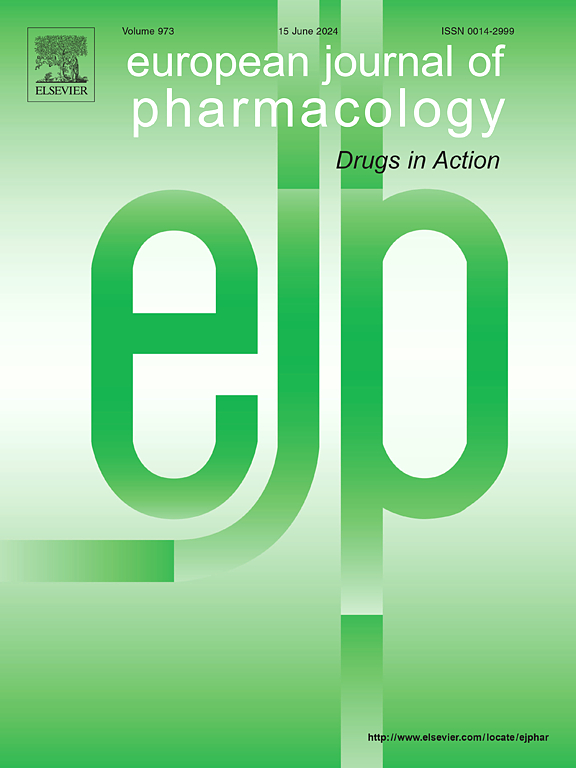Pharmaco-toxicological effects of the synthetic cannabinoids 4F-ABUTINACA, SDB-005, and JWH-018 in mice. In vitro and in vivo studies
IF 4.2
3区 医学
Q1 PHARMACOLOGY & PHARMACY
引用次数: 0
Abstract
Background
Synthetic cannabinoids (SCs) are currently one of the most severely abused new psychoactive substances in the world. However, there remains a notable lack of pharmacological data on the newly emerged synthetic cannabinoids. In the present study, the in vitro and in vivo pharmacological effects of the fourth-generation synthetic cannabinoids 4F-ABUTINACA and SDB-005 are determined and compared to those of the first-generation synthetic cannabinoid JWH-018.
Methods
In this study, the affinities of three SCs for CB1 receptors were evaluated using surface plasmon resonance (SPR) experiments. The acute toxicity of these three SCs was assessed through the up-and-down procedure, while their cannabinoid-specific pharmacological effects were determined through tetrad assays, which examined parameters such as temperature regulation, analgesia, locomotor activity, and catalepsy. Additionally, conditioned place preference (CPP) experiments and a precipitated withdrawal tests were conducted to assess the psychoactive effects and physical dependence of the SCs.
Results
SPR experiments and acute toxicity tests demonstrated that in vitro KD values were positively correlated with in vivo ED50 potency estimates. All SCs were found to induce the classical “tetrad effects” in a dose-dependent manner. Notably, all SCs displayed significant biphasic effects in CPP experiments. Following the administration of the CB1 receptor antagonist rimonabant, a significant increase in head twitches and paw tremors was observed, indicating that the physical dependence manifested after the ingestion of SCs is mediated by the CB1 receptor.
Conclusions
These findings suggest that these SCs have cannabinoid-specific pharmacological effects and abuse potential, providing robust experimental data to support future regulatory efforts.
合成大麻素4F-ABUTINACA、SDB-005和JWH-018对小鼠的药理学效应。体外和体内研究。
背景:合成大麻素是目前世界上滥用最严重的新型精神活性物质之一。然而,关于新出现的合成大麻素的药理学数据仍然明显缺乏。本研究测定了第四代合成大麻素4F-ABUTINACA和SDB-005的体外和体内药理作用,并与第一代合成大麻素JWH-018进行了比较。方法:采用表面等离子体共振(SPR)实验,研究了三种SCs对CB1受体的亲和力。这三种SCs的急性毒性是通过上下实验来评估的,而它们的大麻素特异性药理作用是通过四组实验来确定的,四组实验检查了温度调节、镇痛、运动活动和麻痹等参数。此外,通过条件位置偏好(CPP)实验和沉淀戒断实验来评估SCs的精神活性作用和身体依赖性。结果:SPR实验和急性毒性试验表明,体外KD值与体内ED50效价呈正相关。所有SCs都以剂量依赖的方式诱导经典的“四体效应”。值得注意的是,所有SCs在CPP实验中都表现出明显的双相效应。在给予CB1受体拮抗剂利莫那班后,观察到头部抽搐和脚掌震颤的显著增加,表明摄入SCs后表现出的身体依赖是由CB1受体介导的。结论:这些发现表明这些SCs具有大麻素特异性药理作用和滥用潜力,为支持未来的监管工作提供了强有力的实验数据。
本文章由计算机程序翻译,如有差异,请以英文原文为准。
求助全文
约1分钟内获得全文
求助全文
来源期刊
CiteScore
9.00
自引率
0.00%
发文量
572
审稿时长
34 days
期刊介绍:
The European Journal of Pharmacology publishes research papers covering all aspects of experimental pharmacology with focus on the mechanism of action of structurally identified compounds affecting biological systems.
The scope includes:
Behavioural pharmacology
Neuropharmacology and analgesia
Cardiovascular pharmacology
Pulmonary, gastrointestinal and urogenital pharmacology
Endocrine pharmacology
Immunopharmacology and inflammation
Molecular and cellular pharmacology
Regenerative pharmacology
Biologicals and biotherapeutics
Translational pharmacology
Nutriceutical pharmacology.

 求助内容:
求助内容: 应助结果提醒方式:
应助结果提醒方式:


